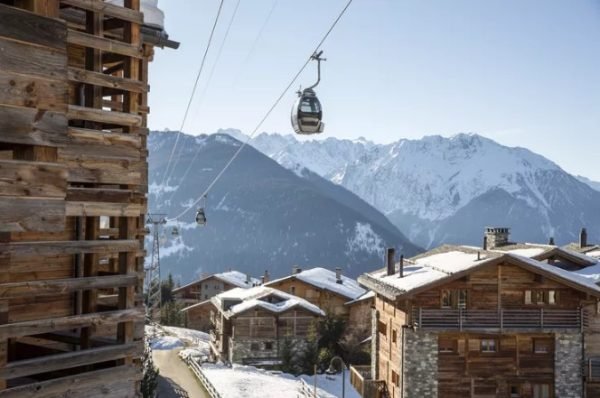Switzerland is practically synonymous with the swish of skis—as the first place in Europe to develop winter tourism, the country’s skiing tradition is long and storied. A long ski season, terrific snow conditions, and large, well-developed resort areas make Switzerland a bucket-list destination for skiers from around the world. A comprehensive transit system of trains, funiculars, cogwheel rails, ski gondolas, and cable cars connect thousands of miles of ski pistes, some of which even cross into Italy, France, Austria, and Germany.
The ski season generally runs from November to March. However, resorts at a higher elevation, or locations with heavy snowfall, may be able to stay open until the end of April. Zermatt and Saas-Fee are able to offer year-round skiing, as a few high-altitude pistes have enough snow to remain open even in the summertime.
December and January tend to be the most popular months, especially during the Christmas and New Year periods. Those charming chalets and snow-capped mountains of the Swiss Alps might be one of the most beautiful places in the world to ring in the New Year with a glühwein, but a lot of people have the same idea — so be sure to book as far in advance as possible, and prepare to pay top dollar for accommodations in high season.
How to Plan Your Switzerland Ski Trip
There are nearly 350 ski resorts across the country, so you’ll need to start by narrowing your choices! If you’re arriving internationally, you’ll most likely fly into Geneva or Zurich, but keep in mind that many popular ski resorts are several hours’ drive or train ride from the airport.
When selecting a place to stay, proximity to the lifts is key. Ski-in, ski-out accommodation is ideal, since you can cruise straight from your front door down to the slopes without needing to lug heavy boots and skis around. However, ski-in, ski-out accommodation will almost always be more expensive than places a bit further away from the lifts. Swiss ski chalets are one of the most popular options — they might be self-catering or managed by staff who’ll provide skiers with a hearty breakfast and sometimes dinner. You can also find everything from simple apartments to luxurious 5-star hotels, some with their own ski shuttles.
When you’re planning your trip, you can also book your ski or snowboard hire and lift passes in advance — often, suppliers offer a small discount for gear booked in advance and for multi-day lift passes. Depending on your home country and insurance coverage, travel insurance that covers snowsports is a must, too.
Top Swiss Ski Resorts
The skiing in Switzerland is truly world-class—the country is home to some of the best, and most famous ski resorts in the world. The Swiss Alps are dramatic, gigantic, and intimidating, so it’s true that many Swiss resorts are best for intermediate or advanced skiers. However, you don’t need to be an Olympic-level athlete to ski in Switzerland, as you can find such a variety of ski terrain geared toward every level of skiier.

Here are some of the top ski resorts in Switzerland to help you plan your trip.
Zermatt: This is one of the most iconic ski resorts in the world, thanks to the presence of the Matterhorn looming large over the charming car-free village. The connected resorts of Zermatt and Breuil-Cervinia in Italy comprise the highest ski resorts in Switzerland, with the highest slope sitting at a sky-high 12,792 (3,899 meters). You’ll find around 223.7 miles (360 kilometers) of pistes in Zermatt, with the majority of those rated red, so best-suited for experienced skiers.
Verbier: Many skiers love Verbier since the resort’s 248.5 miles (400 kilometers) of runs mean you can ski all winter and still barely scratch the surface. It’s part of the vast 4 Valleys ski area, which includes Verbier, Nendaz, Thyon, and Veysonnaz. Verbier also offers heli-skiing and plenty of off-piste opportunities for advanced skiers. The quaint village of Verbier is picture-perfect, with plenty of restaurants and nightlife as well.
St. Moritz: As the first Swiss town to develop winter tourism, St. Moritz remains one of the premier ski resorts in the Alps. This luxury town seems to drip wealth, but it also offers incredible skiing on around 96 miles (155 kilometers) of terrain spread across three ski areas: Corviglia, Corvatsch, and Diavolezza-Lagalb. With its high altitude, St. Moritz is known for its consistently great snow quality, but there’s plenty for non-skiers to do as well as a “see and be seen” apres-ski scene.
Les Portes du Soleil: As the largest ski complex in Switzerland, Les Portes du Soleil has enough variety to keep everyone happy. It’s on the border of France and Switzerland and easily accessible from Geneva. Some of the most popular resorts at Les Portes include Morzine, Les Gets, and Avoriaz. This huge area, 360 miles (580 kilometers) of slopes, gets reliable snowfall throughout the season and also offers plenty of beginner and intermediate runs.
Where to Ski as a Beginner
Beginners shouldn’t be put off by Switzerland’s steep runs, as plenty of resorts cater to both families and beginners. If you’re new to skiing, be sure to invest in a few lessons so that you can learn the basics. Some hotels and resorts offer free kids’ ski schools as part of their family packages. Here are a few resorts to consider if you’re new to skiing:
Saas-Fee: You can find plenty of English-speaking ski schools in Saas-Fee and lots of bunny slopes on which to master your turns. The beginner ski area is separate, so you can practice (and maybe take a tumble or two) without getting in the way of other skiers.
Grindelwald: Grindelwald is a great choice for families, with plenty of ski schools and several bunny slopes, such as the Bodmi practice area, which cater to children. Once you’re ready to head up the mountain, about 30 percent of Grindelwald’s runs are rated blue, meaning they’re on the easier side.
However, everyone needs to start somewhere, so you’ll find ski schools and beginner runs at every ski resort. Beginners can usually buy a beginners-only pass, which offers access to the lower-level learning areas only, but is much cheaper than a full mountain pass.

The resorts of Zermatt and Saas-Fee are some of the best if you want to catch some ski time in June or July.
Zermatt is home to the Theodul glacier. With 13 miles (21 kilometers) of runs, it’s the largest summer ski area in Europe and attracts professional skiers looking to train year-round. The glacier slopes here are beautifully scenic and offer skiers up-close views of the Matterhorn.
In Saas-Fee, skiers can enjoy the Allalin glacier, which includes lots of intermediate slopes and a snowpark. You can leave your thermal layers at home, the weather will be no nowhere near as cold as in the winter months.
Renting Ski Gear in Switzerland
If you don’t have your own equipment or don’t want to lug it with you from home, you can rent poles, skis, and helmets from even the smallest ski resort. You’ll generally need to bring your ski clothing, thermals, and gloves, but if you’re left anything at home, there’s no shortage of ski shops to purchase anything you need.
Rent your gear before you arrive to save time, or pop into any ski rental shop on arrival—they’ll take your measurements and recommend the best gear for both your size and ski abilities. Experienced skiers often use different equipment, allowing for speed and more precise turns, while beginners are better off with wider skis that they can use to learn the ropes and maneuver safely.
Budget Travel Tips
A ski trip to Switzerland usually doesn’t come cheap, but that doesn’t mean you can’t save some money here and there. These tips can help:
Avoid peak season: Visit during the start or end of the ski season. Accommodation and lift pass prices are often higher over the winter holidays, so you might be able to save some money if you’re willing to visit during less popular times.
Self-cater: Dining out in Switzerland is expensive compared to most of the rest of Europe. If you rent a small apartment or home with kitchen facilities, you can prepare some of your own meals to save. Even at smaller resorts, a grocery store is never far away.
Head to smaller, less popular resorts: Smaller ski resorts may have fewer miles of terrain, but they also often have smaller price tags. Or head to a less popular ski resort for more affordable lift passes and fewer crowds.
Enjoy the snow without skiing every day: If the sticker shock of a daily lift pass has you wondering how you can afford to ski all week, know that you can have fun at ski resorts even if you don’t ski every day. Ice skating, tobogganing, winter hiking, or just having a snowball fight are all more affordable ways to enjoy the Swiss winter landscape.
Additional Travel Tips
Make safety your number one priority: Avalanches and blizzards might be what you’re initially worried about when coming to Switzerland, but your fellow skiers are a much more common danger. Always ski safely, move to the side if you need to take a break, and familiarize yourself with the resort’s safety rules to avoid collisions.
Don’t overestimate your abilities: The vast terrain of the Swiss Alps means it’s very easy to end up in a dangerous situation if you’re not careful. Red runs in Switzerland are no joke, so never attempt something if you don’t feel comfortable. Injuries, sometimes serious ones, are common among skiers, unfortunately.
Enjoy the apres in moderation: The apres-ski scene in Switzerland is fantastic—you’ll find parties that go on long into the night, especially in places like Verbier and Davos. Have a great time, but remember that skiing is vigorous exercise, so you’ll enjoy your day of skiing more if you limit your alcohol consumption and get a good night’s sleep the night before.
Bring a trail map: The long runs in Switzerland mean it can be easy to make a wrong turn, especially on days with poor visibility. Always carry a piste map from the resort so you know how to find your way to where you need to go.

